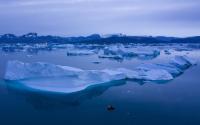U.S. Environmental Protection Agency
Mountains cover close to 20 percent of the Earth's surface, providing a home to approximately one-tenth of the global human population. With their varied topography, steep gradients, and ecological isolation, mountains support a higher diversity of ecosystems and a larger percentage of endemic [see glossary] species than most lowland regions do. Mountainous areas throughout the world provide essential resources such as timber, minerals, recreational escapes, and a significant portion of the freshwater consumed by humans.  The contiguous United States has two primary mountain regions: the western ranges (including the Sierra Nevada, the Cascade Range, the Rocky Mountains, and various other distinct ranges) and the eastern Appalachians. The headwaters of the Missouri, Columbia, Salmon, Colorado, Rio Grande, Hudson, and other great rivers are found in the mountains of the United States.
The contiguous United States has two primary mountain regions: the western ranges (including the Sierra Nevada, the Cascade Range, the Rocky Mountains, and various other distinct ranges) and the eastern Appalachians. The headwaters of the Missouri, Columbia, Salmon, Colorado, Rio Grande, Hudson, and other great rivers are found in the mountains of the United States.
Risks to Habitat
Global climate change poses a number of potential risks to mountain habitats, although scientists cannot predict the impacts with confidence. Despite the uncertainties, researchers expect that over time, climate change generally to affect mountain and lowland ecosystems, the frequency and intensity of forest fires, the distribution of water, and the diversity of wildlife.Studies suggest that a warmer climate in the United States would cause lower-elevation habitats, such as western Douglas fir forests, to expand into the higher alpine zone. Such a shift would encroach on rare alpine meadows and other high-altitude habitats. High-elevation plants and animals have limited space available for new habitat as they move higher on mountains in response to long-term changes in temperature.
Effect on Freshwater
Changes in the depth of mountain snowpacks and glaciers, and changes in their seasonal melting, can have powerful impacts on areas that rely on freshwater runoff from mountains. Rising temperatures may cause snow to melt earlier and faster in the spring, shifting the timing and distribution of runoff. These changes could affect the availability of freshwater for natural systems and human uses, such as agriculture. If freshwater runoff is reduced in the summer months because of earlier melting, soils and vegetation may become drier, increasing the risk and intensity of wildfires. Changes in stream flow and higher water temperatures also could affect insects and other invertebrates that live in streams and rivers, with repercussions up the food chain for fish, amphibians, and waterfowl.
Impacts on Glaciers
Changes in climate already are affecting many mountain glaciers around the world. In Montana, Glacier National Park's largest remaining glaciers are now only a third as large as they were in 1850, and one study estimates that all glaciers in the park may disappear completely in the next 30 years. Researchers have documented rapid mountain glacier retreat in Greenland, the European Alps, the Himalayas, Ecuador, Peru, Venezuela, New Guinea, and East Africa, among other places.






